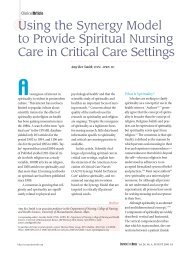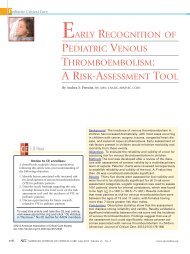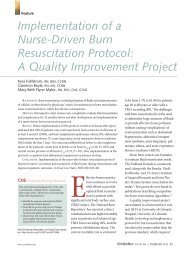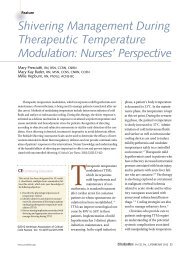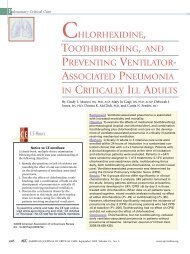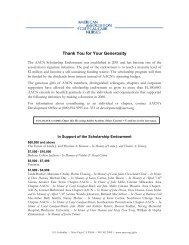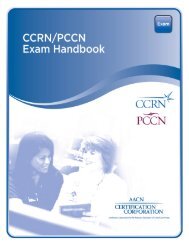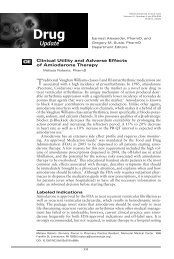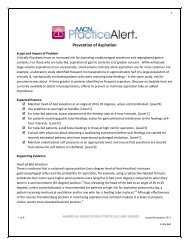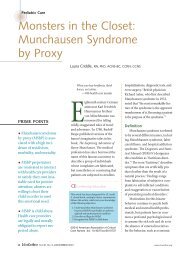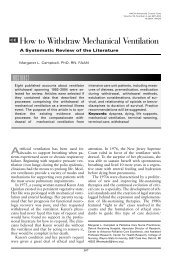The 4A's to Rise Above Moral Distress - American Association of ...
The 4A's to Rise Above Moral Distress - American Association of ...
The 4A's to Rise Above Moral Distress - American Association of ...
Create successful ePaper yourself
Turn your PDF publications into a flip-book with our unique Google optimized e-Paper software.
AFFIRM<br />
➲ Affirm your distress and your commitment <strong>to</strong> take care <strong>of</strong> yourself:<br />
Prolonged or unrecognized suffering due <strong>to</strong> moral distress can be detrimental <strong>to</strong> your personal<br />
and pr<strong>of</strong>essional life. • You have an opportunity <strong>to</strong> be free from moral distress.<br />
• You have a pr<strong>of</strong>essional responsibility <strong>to</strong> contribute <strong>to</strong> the creation <strong>of</strong> a healthy<br />
work environment.<br />
➲ Validate your feelings and perceptions with others:<br />
Talk <strong>to</strong> coworkers, nurses in other settings, or friends and family <strong>to</strong> seek validation for<br />
what you are feeling. • AACN’s national <strong>of</strong>fice and local chapters are additional sources <strong>of</strong><br />
validation.<br />
➲ Affirm your pr<strong>of</strong>essional responsibility <strong>to</strong> act:<br />
ANA Code <strong>of</strong> Ethics: <strong>The</strong> nurse owes the same duties <strong>to</strong> self as <strong>to</strong> others, including<br />
preservation <strong>of</strong> personal integrity and wholeness <strong>of</strong> character. • AACN’s mission<br />
supports the establishment <strong>of</strong> work and care environments that are respectful, healing,<br />
and humane. This mission is guided by values that include accountability, advocacy,<br />
and integrity. • Healthcare institutions have a moral responsibility <strong>to</strong> define and<br />
communicate their values <strong>to</strong> their employees and <strong>to</strong> the public. Each employee is<br />
accountable for upholding those values.<br />
✪ GOAL: You make a commitment <strong>to</strong> address moral distress.<br />
ASSESS<br />
➲ Identify sources <strong>of</strong> your distress. Under what circumstances do the signs<br />
and symp<strong>to</strong>ms occur? Do other people experience distress/suffering related <strong>to</strong><br />
these sources? Sources may be personal, interpersonal, and/or environmental.<br />
Examples may include the following:<br />
A particular patient care situation may be a cause <strong>of</strong> distress; for instance<br />
if you are asked <strong>to</strong> provide care that you feel is unnecessary or not desired<br />
by the patient or family.<br />
A unit policy or practice can be a source <strong>of</strong> distress that manifests as a<br />
pattern <strong>of</strong> suffering that reoccurs whenever a certain situation is present; for<br />
instance, the way your unit provides end-<strong>of</strong>-life care or the way that family<br />
meetings are held may be practices that cause distress.<br />
Lack <strong>of</strong> collaboration may be a cause <strong>of</strong> distress; for instance, if you experience<br />
disrespectful interactions with other members <strong>of</strong> the healthcare team, feel<br />
powerless <strong>to</strong> uphold what you believe is best for the patient, or have feelings<br />
that fellow providers do not validate.<br />
➲ Determine the severity <strong>of</strong> your distress. Rate your distress on a scale <strong>of</strong> 0 <strong>to</strong> 5<br />
(0=not distressed at all <strong>to</strong> 5= very distressed).<br />
4



